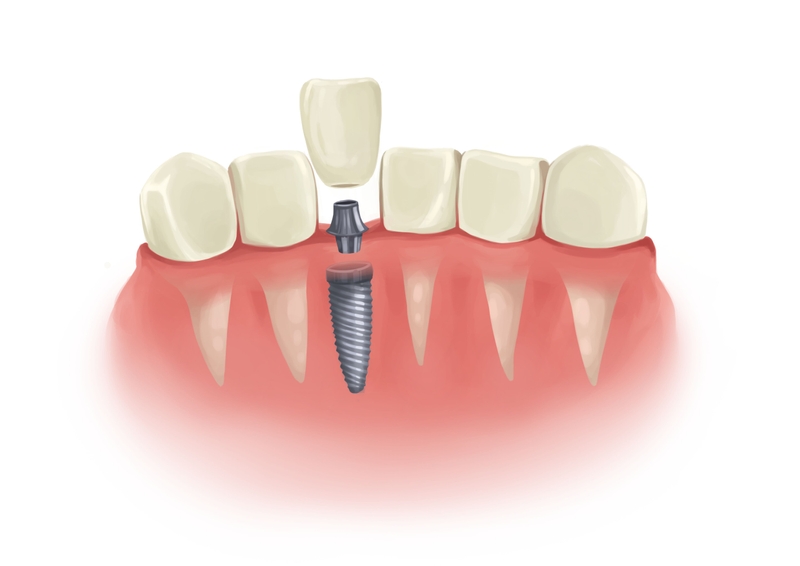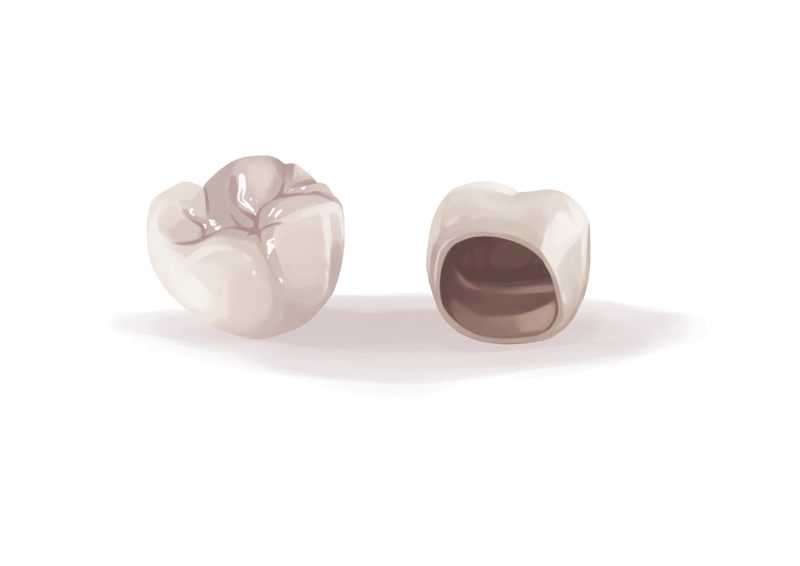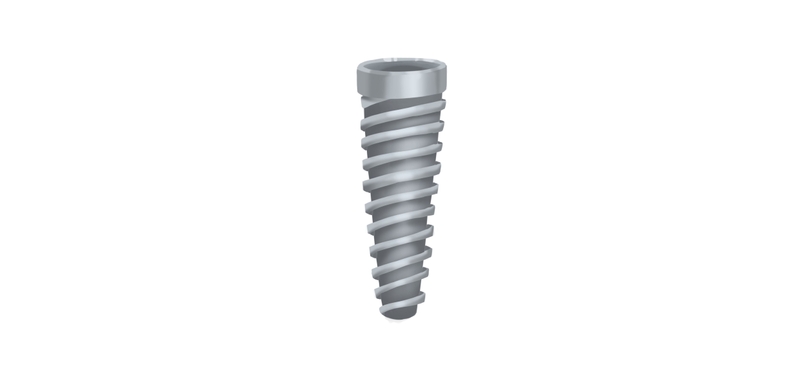- Surgical trauma, gum disease and faulty implant design are some of the causes of a loose implant.
- Symptoms of a loose implant include pain, mobility and bleeding. Treatment depends on which component is affected (abutment, crown, implant itself).
- Loose dental implants can lead to serious complications and require an emergency dentist.
Loose dental implant? Use Authority Dental to find express emergency dental care near you.
Do you feel that your dental implant has become loose? Here's everything you need to know.
Symptoms of a loose dental implant

Picture by Authority Dental under CC 2.0 license
Most often, the patient can determine for himself or herself that a part of the prosthesis is loose. Touching it with your tongue or fingers might be enough to recognize a problem. It is important to contact a dentist immediately in order to prevent further damage.
Harry Lee, DMD, shares his professional experience: "When a patient calls with a 'loose implant,' the first thing I do is reassure them that it is usually not the worst-case scenario."
"The implant itself—the titanium screw—is fused to the bone, and it is actually the least likely part to fail. In my experience, and based on conversations with colleagues, nine times out of ten the issue is a loose abutment or loose crown—the parts attached to the implant," he explains.
Signs of a dental implant loosening include:
the artificial tooth moving,
pain, especially while chewing,
sunken-in gums,
bleeding upon touch,
discoloration in the affected area, and
The tooth cap is falling out.
If you notice these symptoms, report them to your dentist; they will likely order an X-ray. A clinical inspection will then reveal which part is moving, as it might not be the implant itself.
More often than not, it is the abutment or crown that is loose. This is good news, as the whole implant fixture may not have to be removed from the bone. All mobility related to an implant is impaired, nonetheless, and should be dealt with as soon as possible.
Diagnosis and treatment may be more difficult when one implant supports two or more crowns, or even a denture.
Causes of a loose dental implant
Some issues can arise soon after placement or during the recovery period, while others can become apparent years after. In either case, the complication can be caused by different factors.
Early
Surgical trauma
Overheating during the procedure
Non-ideal placement
Complicated wound healing
Insufficient stability
Initial overload
Lack of implant torque
LATE
Lack of osseointegration
Infection
Biomechanical overload
Faulty design of the implant or component
Gum disease
How the problem is addressed depends on the affected element. This could be the crown, abutment, or the implant. Leaving any of these parts loose and untreated could lead to implant failure as well as complications for the entire body.

Most common: loose dental abutment

Picture by Authority Dental under CC 2.0 license
The abutment is the component that connects the implant to the tooth cap (crown). This is the part that loosens most often, accounting for 33% of cases. It often causes no pain and can usually be fixed without further damaging the rod or crown.
Abutments usually loosen due to trauma, faulty design, or overload. The last can also be associated with the incorrect placement of the rod. This case might require the removal of the implant.
Treatment
Ideally, the abutment should be removed along with the crown, which can then be detached outside the mouth. This would involve unscrewing the prosthesis. The tooth cap might be saved, reducing your costs.
Sometimes it is not possible to remove the abutment without damaging the crown. In such cases, it might have to be sectioned or cut off with a drill. Your dentist can attempt to get a hold of a master cast from the lab that made it or make a new one.
You might have to wear a temporary restoration for a few weeks.
Easiest to fix: loose dental implant crown

Picture by Authority Dental under CC 2.0 license
The crown is the part of the restoration that is visible in the mouth. It can be made of several different materials, the most common being porcelain.
A loose implant crown comes about due to trauma and fractures. Those can be caused by grinding teeth and injuries. If it is moving, there is likely a crack in the tooth cap itself or in the cement holding it.
Treatment
The treatment of a loose dental implant crown is similar to that of a damaged abutment. It is unscrewed if possible. If not, the crown may be extracted, provided the cement is sufficiently fragile to allow it. Otherwise, it is cut up into smaller parts. The abutment or rod is then thoroughly cleaned.
If a dental implant crown fell out completely, but is still in good shape, it can be cemented back in place. This is a simple procedure and may not require anesthesia.
The situation is more complex if the crown gets damaged. The dentist can try to obtain the previously taken cast or make a new one. Either way, you are likely to wear a temporary one for a few weeks.
Screw-retained crowns can sometimes become loose, leading to a loose crown or abutment. This is very easy to fix by retightening.
Worst case scenario: loose dental implant

Picture by Authority Dental under CC 2.0 license
The biggest problem emerges when there is an issue with the implant itself. There may be pain, numbness in the lips, and maybe even inflammation in the gums.
These symptoms occur when a dental implant becomes infected. Ignoring them could lead to severe complications.

The most common cause of a loose implant is infection combined with bone loss. It can also be caused by trauma or overloading. The first can be triggered by poor oral hygiene, smoking, and some medicines. The second occurs if the design is faulty or the placement is not ideal.
Treatment
Loose dental implants always require complete removal. If there is bone loss, you may need grafting. This includes additional months of healing. The next step is to reattempt implantation or to fit a denture. The dentist will discuss options with you.
If you do not require grafting, you may be fitted with an implant of greater dimensions immediately. That way, it still has a chance of successful osseointegration after removal. There must, however, be no infection or periodontitis.
It may be possible to reuse the crown, which can save you significant costs. The removal process will still require proper aftercare, possibly antibiotics, and painkillers.
FAQ
Is a loose dental implant an emergency?
Yes. It is one of the most dangerous dental implant problems. If you notice any mobility in your dental implant, you should immediately seek help from a professional.
Loose dental implant screws can lead to bone loss, infection, implant fracture, and even implant failure. If you leave it untreated, an infection could spread to other parts of your body, threatening your overall health and even your life.
What to do if a loose implant has fallen out?
Contact your dentist. Keep the fragment that has fallen out. Avoid eating until the problem has been fixed. Use non-alcoholic mouthwash to disinfect your mouth.
If the piece that fell out is in good enough shape, it may be reattached, and the whole thing could be fixed in one visit. Sometimes this is not possible, but the dentist can fit you with a temporary piece until a new one is ready.
How to prevent a dental implant from becoming loose?
Avoid sticky, crunchy, and hard food as much as possible and conduct excellent oral hygiene. This can help avoid other tooth implant problems as well. Implants cannot get cavities, but the tissues surrounding them are prone to infections. Those can lead to the fake tooth loosening due to bone loss.
Keep up with regular exams and cleanings as recommended by your dentist. The rule of thumb is to come in at least once a year. It is much easier to fix issues spotted early. It is also a good idea to limit your alcohol intake and quit smoking. Both of these habits can lead to an infection.
References
- Dental implant infections
- The Dreaded Loose Abutment Screw: Etiology, Management, and Prevention
- Errors in Implant Positioning Due to Lack of Planning: A Clinical Case Report of New Prosthetic Materials and Solutions
- Bruxism: A Literature Review
- Occlusal overload with dental implants: a review
- Successive Reimplantation of Dental Implants Into Sites of Previous Failure
- Osseointegration: An Update
Harry Lee, DMD
I would explain that the implant is like a car with three main pieces: the wheel hub is the implant, the lug nut is the abutment, and the tire is the crown. Most of the time, the lug nut or the tire is just loose or damaged. This can often be solved quickly by simply unscrewing the crown and re-tightening the abutment screw. It is a fast, non-surgical repair, but it is crucial to treat it as an emergency, as the wiggling motion can damage components beneath it.